Technology
Checkout Huawei Kirin chipsets technology progress

Huawei Kirin had an inspiring journey in chipsets technology. The company has gone through several ups and downs yet managed to achieve a huge name and fame in the mobile application processor market. Huawei chipsets progress is something that one must have a look at.
From K3V1 which almost proved a failure, to the super-dynamic Kirin 9000 chips, the Chinese firm never gave up and has shown great improvements in the processor field.
Over years, we have seen many limitations in Kirin’s headway. The reasons were high competition, and the burden of the U.S. sanctions caused HiSililcon to stop printing new chipsets. However, throughout the journey, Huawei proved that a focused mindset and hard work bring you to the doors of success.
And today, we will learn how Kirin chips have evolved over the years.
Kirin’s impact on chipset technology
So far, Kirin chipsets have remained industry-leading processors for smartphones. It’s a group of 32-bit and 64-bit smartphone ARM cores introduced by HiSilicon (Kirin designer). To date, the industry has produced several tech-pack chipsets for smart gadgets.
Kirin 910 – First Generation Kirin Solution
After two HiSilicon K3 chipsets (K3VX and Kav2 – which didn’t gain much attention from consumers) Huawei introduced the first-generation Kirin solution – Kirin 910 in 2014. The processor stands over 28nm HPM process and adopts a quad-core Arm Cortex-A9 CPU.
Alongside, it features Mali-450 MP4 at 533 MHz GPU. To deliver fast and smooth functioning, the processor exhibits LTE Cat 4 Modem and LPDDR3 at 800 MHz memory. At that time, these were the best elements to impose in a processor.
Kirin 980 – First commercial 7nm SoC
In 2018, leading the market, Huawei announced the Kirin 980 chipset as the first commercial 7nm process SoC. Compared to the traditional 10nm packaging, these processors were capable of providing 20% improved SoC performance and 40% more power efficiency.
In addition, it also provides a cluster of tools that simplifies the difficulties of tough AI frameworks and enable developers to easily define the leading processing power of the chipset.
As of the efficient implementations, Huawei Kirin chipsets became quite impactful in the market. The chipset’s influence was so high that even giant tech makers such as Apple and Qualcomm seemed in danger. Everything was going well until U.S. conflicts came into the pathway.

U.S. Sanctions
In 2019, Huawei has been restricted to utilize U.S. technologies and its services. Consequently, the company was not allowed to purchase any tech-related components or to sell them. This action has put Huawei in huge trouble.
Due to these regulations, the company has faced severe technology supply issues. However, something that has been much affected was the Kirin chip production. As a result, Huawei has to stop printing new processors through third-party manufacturers (TSMC).
Present scenario of Kirin chipsets
Kirin 9000 is the latest as well as the last Kirin structure that we have in our midst. The processor came along with the Mate 40 series. Thereafter, the company started relying on Qualcomm’s cooperation for its Snapdragon chipsets.
On the flip side, a few reports suggest that Huawei’s chipset market share has been affected badly due to the low production and supply problems. Meanwhile, industries likes MediaTek, Qualcomm, Apple, and UNISOC are taking advantage of HiSilicon’s decline.
There was a time when Kirin covered the entire market, and companies like Qualcomm were tense about their production.
However, Huawei is not going to give up so easily. In recent times, we might see Huawei preparing for Mate 60 probably with a new chipset. It would be no less than a surprise if the processor really comes onto the consumer platform.
Huawei is making every bit of effort to once again bring the Kirin chipsets to the technology surface. Despite challenges, Huawei is trying to re-establish the supply chain and we hope to see some effective changes in the future.
Below you can check the HiSilicon Kirin chipset released in the past:
- HiSilicon K3VX – TSMC 110nm
- HiSilicon Kav2 – TSMC 40nm
- Kirin 910 – TSMC 28nm
- Kirin 920 – TSMC 28nm
- Kirin 925 – TSMC 28nm
- Kirin 930 – TSMC 28nm
- Kirin 935 – TSMC 28nm
- Kirin 950 – TSMC 16nm
- Kirin 955 – TSMC 16nm
- Kirin 960 – TSMC 16nm
- Kirin 970 – TSMC – 10nm
- Kirin 980 – TSMC 7nm
- Kirin 985 – TSMC 7nm
- Kirin 990 – TSMC 7nm
- Kirin 990 5G – TSMC 7nm
- Kirin 9000 series – TSMC 5nm






